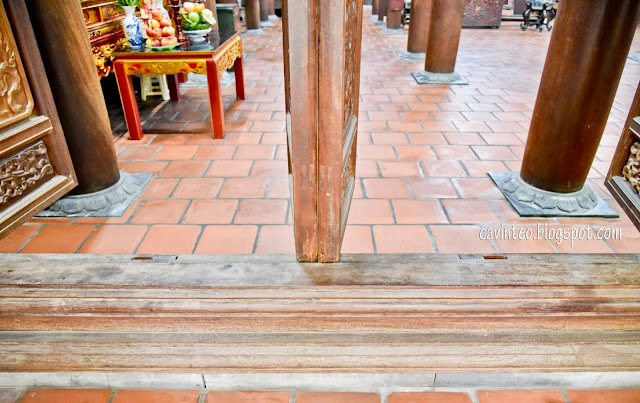With origins stretching back to almost a thousand years, we expected the Ba Da Pagoda to have a much grander entrance, instead of just a small opening that we literally walked past while in search of the temple.
The narrow alley opened up to a surprisingly larger courtyard that was as unexpected as seeing that tiny entrance. With fallen leaves on the ancient looking tiled roof, the atmosphere was calm and serene, contrasting with the bustle of the road outside that led to the more crowded Saint Joseph Cathedral.
Anyone knows what tree is this? It provided not just shade with its sky reaching branches but also contributed to the ancient outlook of Ba Da Pagoda.
Guess the right one was a monument with encased stone tablets. The four characters on top are Chinese and translated to the common Buddhist saying: Amitabha.
Such big fruits! I am always tempted to want to know how they taste!
Question: dragon or lion?
Wood divider before entering the temple. I remember there were some practical usage to the dividers although the one thing I remember better was that we were informed to walk over and not step on the divider when we enter / exit; some superstition.
Airy interior of the temple. While it was said to originate from year 1056 under the name "Sung Khanh Pagoda", it was not known as Ba Da until the 15th century with the discovery of a stone statue of a lady that was found near the Thang Long citadel. Interestingly, the statue went missing after a rebellion and the temple was also razed to the ground.
This current structure was built in the 1800s and stood out from the center altar were the appearance and layout of the statues of Buddhas and Bodhisattvas. The statues seemed to be made of metal but with stains more associated with wood.
Other altars; for the bottom picture, it should be Kṣitigarbha Bodhisattva, renowned for his noble vow that he shall not "achieve Buddhahood until all hells are emptied".
I thought that was it until I saw the passages on the sides of the main temple. Since we were already there, why not explore further right? It's not as if we were rushing for time although I must admit my travel mates had been very accommodating!
A wooden building can only show so much and in this case, the flags and the lanterns added colors and vibrancy. The power of visual in the contemporary era; similar to the popularity of cafes that corresponds to how instagrammable the premises are.
More of the 'monuments'.
Turned out there were mini altars!
Altars in the center building behind the main temple; I am guessing they were for former abbots of the temple who had passed away, given the display of portrait photographs and paintings.
Ba Da Pagoda is also the headquarters of the Municipal Buddhist Association; maybe that's why there were so many tables and chairs.
Catching my attention was this bookcase filled with scriptures that were from the Emperor Qianlong (Qing Dynasty) era. Likely replications lah; if they were indeed a few centuries old, they would likely be kept away from the public.
Random photos.
Exiting from the main entrance. We didn't make a mistake and exit from the side gate, if any. Come to think about it, this narrow path would be a serious safety issue if the temple is crowded with people during main festivals.
=====
Số 3 P. Nhà Thờ, Hàng Trống,
Hoàn Kiếm, Hà Nội 100000, Vietnam
Map
As above.




























No comments:
Post a Comment